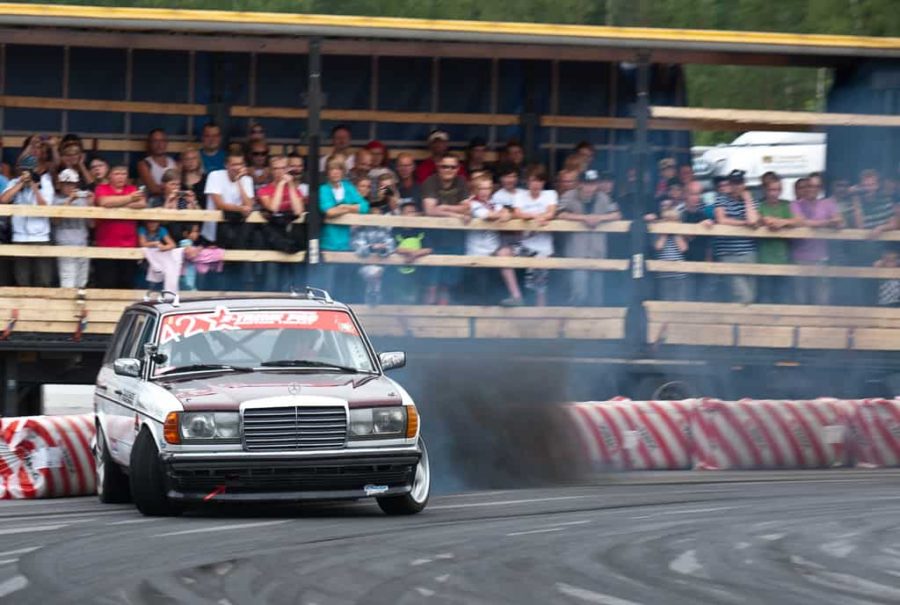Here on 240Drift, we don’t talk much about the different types of engines. Sure, we mention the different configurations, the number of cylinders, and even the occasional rotary (if we’re feeling spicy). One thing we have yet to mention, however, are cars that don’t run on pump gas. What about cars that run on diesel, can they drift?
Drifting a car with a Diesel engine is possible, but requires a different style of driving. With a very limited torque band, no horsepower to speak of, and generally close-ratio gears, a driver needs to be very talented to pull this off.
There’s plenty of good chassis that have diesel engines pre-fitted. From BMWs to Volvos, and even some pickup trucks, you’re sure to find a body style that suits you. Even if you don’t, a Cummins-swapped 240 isn’t unheard of! Contrary to finding the vehicle, drifting it isn’t easy. What’s different about drifting a diesel?
Limited Torque Range
Despite diesels having an incredibly high torque figure (due to their longer combustion time and large displacement), that peak torque isn’t for long. Once a diesel revs out of its range, its power significantly drops. Due to diesel taking a long time to burn, it can provide a continuous force on the piston for longer.
Once you begin to spin faster, that force has less time to push the piston before the exhaust valve opens, and the rest of that potential energy is wasted. This results in the black smoke you see coming out of many diesels, or “rolling coal”. That phenomenon can also be achieved by running the engine incredibly rich, which also results in the engine not being able to burn all the fuel before the exhaust valve opens.
Peak torque in a diesel engine occurs at roughly 1750RPM. Keeping a drift going while at such low RPM requires a very tall gear and incredible control over the car.
Lack of Horsepower
While diesels have a ton of torque, that doesn’t always translate into usable power. The equation for calculating horsepower is (Torque*RPM)/5252 . There’s a long explanation as to why the number 5252 was chosen, but that’s a topic for another day. While a diesel engine may have 400 or more fl-lbs of torque, if that torque happens at 2000 RPM, then you essentially have torque times 2/5, or roughly 160 horsepower.
While torque is good for lower-speed drifting, you need horsepower (or incredibly tall gears) to be drifting at high speed. The rev range to maintain such a speed drifting simply isn’t there with a diesel, as it would be with a 8,000RPM SR20, or even a 6,000RPM LS engine. When you’re dealing with a redline of ~3500, you start to feel the lack of flexibility in your engine, especially since your usable torque is only half that range.
Close-Ratio Gears
Most gearboxes that are mated to diesel engines run very close-ratio gears. Since the usable torque in a diesel engine is so little, every gear has to be closer to the rest than in a gasoline engine’s gearbox. These closer gears allow the RPMs to stay in that range after shifting, providing peak torque for as long as possible.
While all these factors may be good for driving, they aren’t nearly as good for drifting. As mentioned before, the lack of horsepower doesn’t allow for a diesel engine to rev up, and the gearbox doesn’t let it spin its wheels as fast as other cars. That equates to a good low-speed drift car. However, at higher speeds, this car would have no business going sideways.
Where Are Diesel Drift Cars Good?
 Despite all of these issues, I’m not saying a diesel can’t drift. I’m just saying it’s very difficult for it to do so at any kind of speed. For a low-speed drift car, a diesel engine isn’t a bad choice.
Despite all of these issues, I’m not saying a diesel can’t drift. I’m just saying it’s very difficult for it to do so at any kind of speed. For a low-speed drift car, a diesel engine isn’t a bad choice.
Whether you should have a diesel really does just depend on where you’re drifting. If you know your local track is a small one like Tsukuba, then the excess of torque and close gear ratios would be an advantage for you. However, if your local track happens to be Mugello, you’re not going to like your diesel car during all the long, sweeping drifts.
They’re also cost-effective. While they’re generally worse for initial price, and sometimes for emissions, they are very fuel-efficient. This is assuming it hasn’t been tuned to “roll coal”, of course. This, combined with your tire costs going down (generally lower wheel-ground speed difference), will help significantly reduce the cost of your drifting over time.
You have to ask yourself whether it’s worth the trade-off, though. Would you be happy drifting a diesel car, being limited to small tracks? If not, would the reduced cost make up for the difference?

